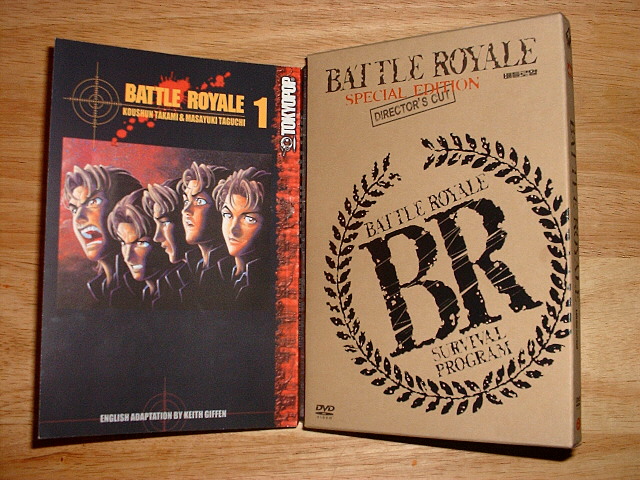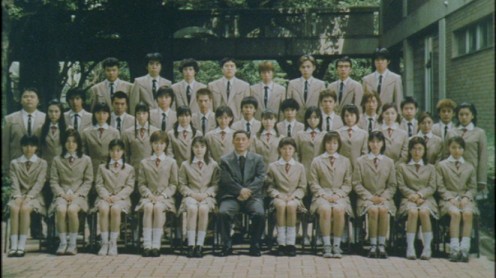|
From TheSmartMarks.com Movies / TV Battle Royale: Director's Cut The director, the recently deceased 70-year-old Kinji Fukasaku (in collaboration with his son, Kenta) apparently had grown quite cantankerous and feisty in his advanced age. It took some balls to take on this project. Known chiefly for redefining the yakuza genre post World War II, Fukasaku decided to bring the extremely popular but highly controversial novel, Battle Royale by Koshun Takami to the big screen. He was immediately met with opposition from all sides and this was in the planning stages, before any actual filming had even begun. Once the film was complete, the Japanese Diet (parliament) encouraged theaters not to show it, an especially noteworthy and surprising measure considering their government generally doesn�t interfere where it concerns violence in movies, television, music and video games. The film went on to create just as much of an uproar and became more notorious than the book that preceded it. 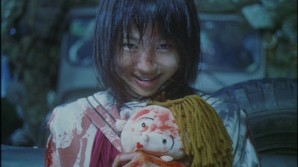 A recent BR winner grins for the camera to start the movie. So what is the big deal you may ask? Perhaps the powers-that-be in Japan were less concerned with the source material being adapted for mass consumption on film and were in fact more worried about Fukasaku�s pointed commentary on Japan�s political and social state. (it�s no secret that Japan fears its youth and the youth are distrustful of their elders and feel pushed around by them) Fukasaku lets both parties know that they should feel the way they do. Fear the youth, don�t trust adults. 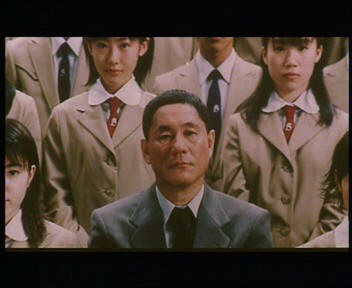 Fukasaku made a few changes from the novelization that made the world represented in his film more closely resemble our own. (for example, in the novel Japan, along with Germany, won WWII and the Japanese government exercised absolute control over its citizens. Free speech was prohibited and anyone who spoke out against the government was executed) Fukasaku�s vision is set �at the dawn of the millenium� and Japan is on the verge of economic collapse. Mass unemployment strains the home lives of its inhabitants and juvenile delinquency rises as families crumble and fall apart. With over 800,000 students boycotting school and youth crime peaking, the all-powerful government is panicked into action. They institute the Millennium Educational Reform Act V also known as the BR Act to control the rebellious youth. The Battle Royale act enables the government, through random lottery, to periodically select a ninth grade class to participate in a deadly game of survival of the fittest on a deserted island. The current crop of contestants have been convinced that they are going on a field trip before they are gassed and hauled to the island. When they awake in a strange classroom with even stranger metal collars around their necks, they are confronted by their former teacher, Kitano (played by the yakuza actor/director legend, the stoic and deadpan, Takeshi �Beat� Kitano). With the help of a cheery instructional video (a darkly humorous and surreal moment...the video's hostess is VERY upbeat about killing), Kitano informs the class that they have indeed been selected to compete in this latest Battle Royale. The rules are simple: 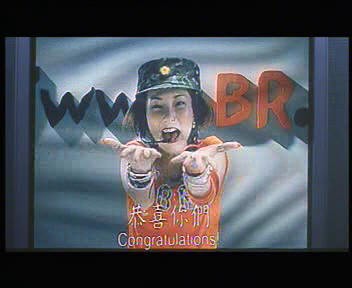 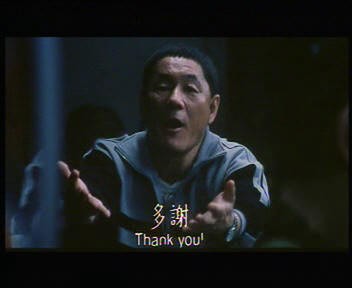 The students have three days to kill each other until only one remains. The winner gets to return home to a normal life. At the end of three days if more than one student remains, they all die. If twenty-four hours passes without a fatality, they all die. This will all be enforced by the neck collars. The collars monitor their vitals and location and if you attempt to remove them, they explode.  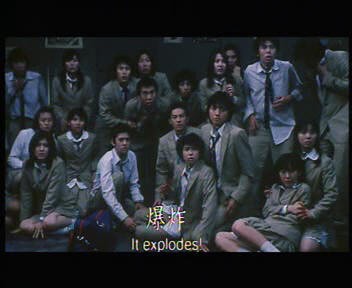 To illustrate the effectiveness of the collars, Kitano takes great pleasure in detonating the collar of one of the more troublesome miscreants, killing him in front of the stunned class. 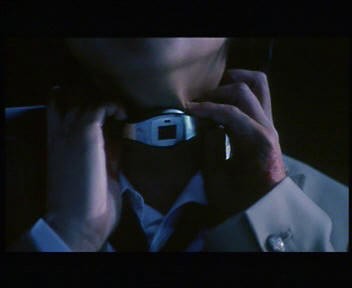 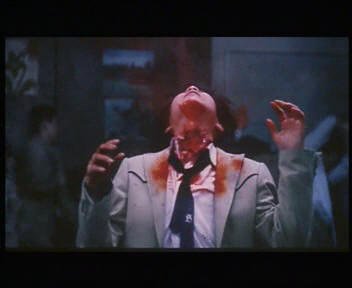 In addition, periodically certain areas of the island will be deemed �danger zones�. Linger in a danger zone and your collar will detonate. This is to keep the students moving and in constant competition with one another, not giving them enough time to hide out. Each student is given a bag with three days worth of provisions and a random weapon inside. The weapons range from deadly (guns, knives, hand grenades, sickles and crossbows) to the utterly useless (binoculars, pot lids). This is to eliminate any natural advantages the teens may possess. Sent into the wilderness at night one at a time, the game begins. 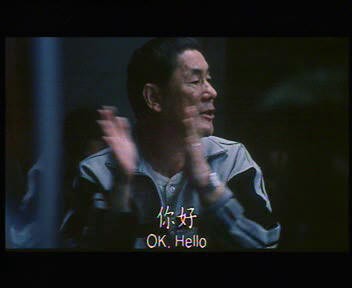 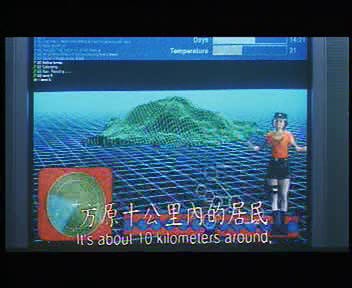 So how does one react when faced with the prospect of stabbing your best friend or potentially having to shoot your secret crush? It is a difficult decision but not one the kids have a long time to ponder. Some turn savage ala Golding�s Lord of the Flies and go about the killing business rather mercilessly. Others attempt to cooperate peacefully and attempt to beat the system. Some of the weaker wills, unfortunately, take their own lives rather than participate. All 42 students have their own motivations and backstory and each of them, suprisingly, is built-up and fleshed out well through regular flashbacks. (but generally, it is right before they die). An amazing feat given that some movies have over two hours to work with and can�t manage to make their audience care about even one character. Note: It's not necessary but it wouldn't be a bad idea to read either the novel or the manga before seeing Battle Royale. Both are currently available in English and they have more time to cover the characters individually, getting into their heads and exploring their backgrounds. There are things that are alluded to in the movie but never fully discussed and won't make sense to you unless you read the source material. Unfortunately, due to time contraints and such, these things had to be left out. But you'll find that Fukasaku was still very true to all of his on-screen characters and they don't differ much from their original counterparts. Learn all about Mitsuko's alcoholic and abusive mother, her exploits as a prostitute and more! However, we are clearly meant to empathize most with two of the main characters; a young boy named Nanahara and the girl he has sworn to protect, Noriko. 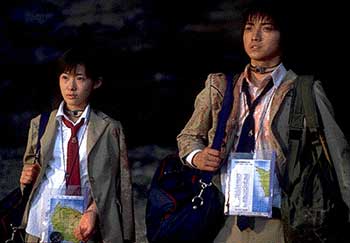 Noriko and Nanahara vow to be friends til the end. The two agree early on that they can only trust each other and set about not playing the game so much as simply peaceably surviving it. The ultimate ko-gal, Mitsuko (my favorite character), takes to mass murder like a fish to water since she is the outcast of the bunch and uses her good looks and cunning to gain the trust of and get close to her competitors � close enough to kill them. 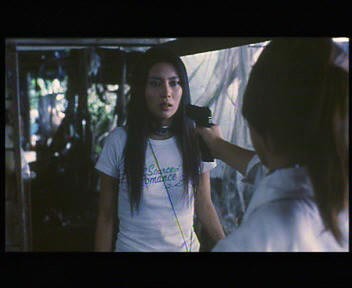 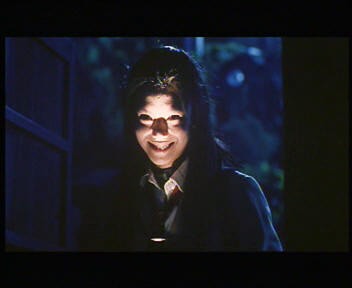 Then there are two �transfer� students that Kitano seems to already know: the silent and psychotic Kiriyama and the enigmatic Kawada. While it is said that Kiriyama volunteered for BR for fun, no one knows what to make of Kawada. Kawada does take a liking to Nanahara and Noriko and vows to protect them both and lead them safely to a way out of the game. But can they really trust him? 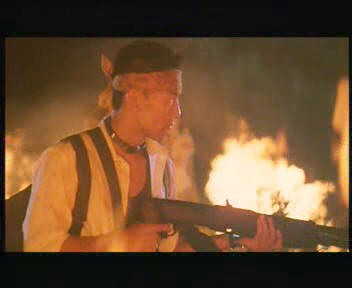 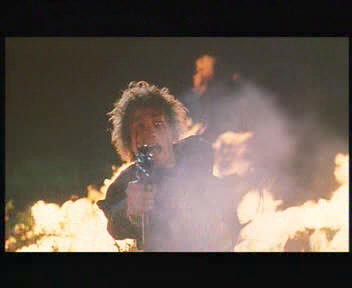 The tension builds slowly and masterfully as we watch all the old high school politics play out, but this time for life and death. Now romantic rivals have automatic submachine guns. The bullies have to watch their backs and rival cliques haven�t forgotten old beefs. Guys attempt to lose their virginity (by force) before they die, others spend the entire movie just trying to find the girl he has a crush on to tell her he loves her. (awwww!) But as distrust and paranoia sweep over the combatants we see friends become enemies, allegiances form and dissolve as they all spiral into depravity, some becoming instinctive, animalistic monsters along the way. 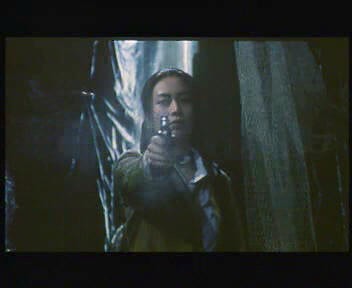 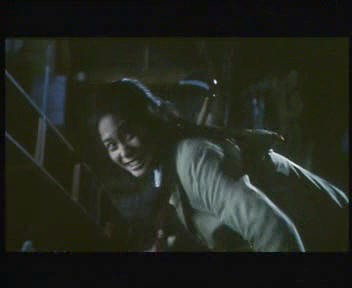 Why is America so afraid of this movie? You can attribute the hesitancy to release BR here in America to many factors. The first to spring to mind is the extreme level of violence. But truth be told, I can think of at least five early eighties action movies that were more violent. What gives BR�s violence its power is its senselessness. But is that not the point? Violence is senseless. Violence is depressing. BR doesn�t glamorize the violence nor is it highly choreographed. The deaths are brutal and honest and hard to watch because you care for the kids. The deaths are sad. You don�t cheer them on, you wish for them to cease. Next to Beat Takeshi�s own films, this is probably the best example I can think of where a film uses extreme violence as an anti-violence message. 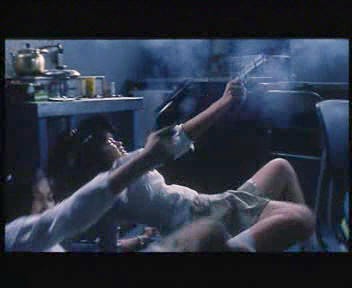 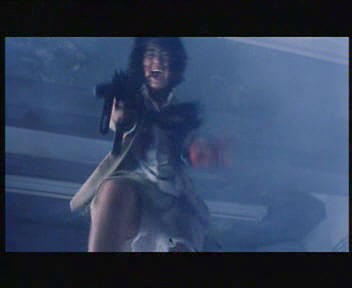 Another problem is the US is reluctant to confront its own teen violence problem. Since Columbine the subject is virtually taboo, especially in Hollywood. Countless movie plots and even simple titles have been changed to accommodate the politically correct or in fear of offending someone. You can�t even suggest teens and violence in the same sentence anymore. Battle Royale is 99.9% teen-on-teen violence. Boys and girls alike get it equally; they die tragic, gory and grisly deaths. As Westerners, we�re simply not accustomed to seeing that. On top of that, the vast majority of the kids who die aren�t bad kids at all, merely victims of circumstance. They aren�t evildoers in the latest Hollywood blockbuster receiving their comeuppance at the hands of a hero for past transgressions against mankind. They are innocent 15-year-olds (played by children roughly the same age, not 27-year-olds that can pass for 15) in the wrong place at the wrong time, forced to slay their peers in a competition more cutthroat and competitive than any Japanese schoolhouse or corporate boardroom. 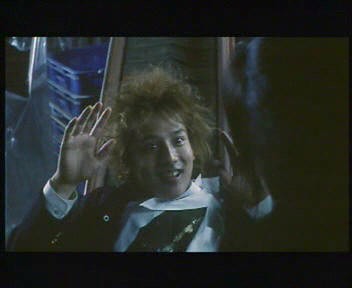 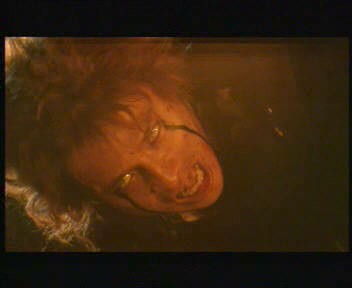 Just think: if this movie created an uproar in a country that generally doesn�t bat an eyelash or bother to raise an eyebrow at such ideas in their entertainment, what sort of reaction would it be likely to receive on these shores? I can already hear Bill O�Reilly�s impassioned speeches, defending and protecting us all, droning on and on about the corruption of our children. He and those like him will deem Battle Royale exploitative and gratuitously violent and choose to focus on the gore or the likelihood of copycat incidents, rather than address our society�s real problems. (i.e. why we are raising more and more morons who cannot even comprehend the difference between fantasy and reality). The naysayers will do all these things, likely without having even seen the film. The truth is teenagers (who possess the common sense and ability to understand it) NEED to see this movie. Like Requiem for a Dream was a slap in the face and a long overdue PSA about the dangers of drug use, Battle Royale is a well-crafted warning and thought-provoking message to the young and old generations of Fukasaku�s homeland and any other country that might benefit. The premise is confrontational, controversial and hard to swallow, but like the films of Spike Lee have proven time and time again, sometimes you have to be in-your-face, audacious and outspoken in order to grab people�s attention, keep it and have them actually listen to your message. Behind the fa�ade of wall-to-wall classical music, histrionic opera tunes, guts and soapy melodrama there is a method to the madness. If your intellectual limitations don�t allow you to see or hear that, then society has a lot more to worry about than a simple movie. While it doesn't have American distribution as of yet, it is extremely easy to find DVDs of Battle Royale anywhere on the net where foreign films are sold. I'd start with HKFlix.com.  Holla at'cha, boy! © Copyright by TheSmartMarks.com |
